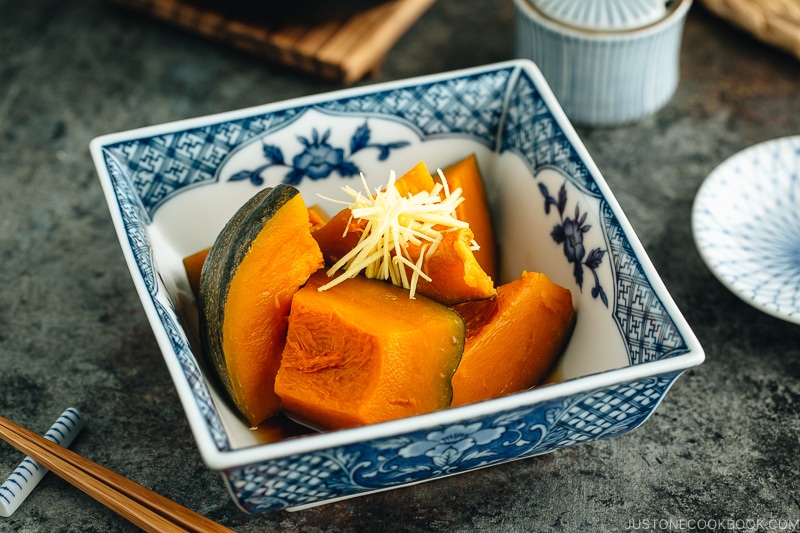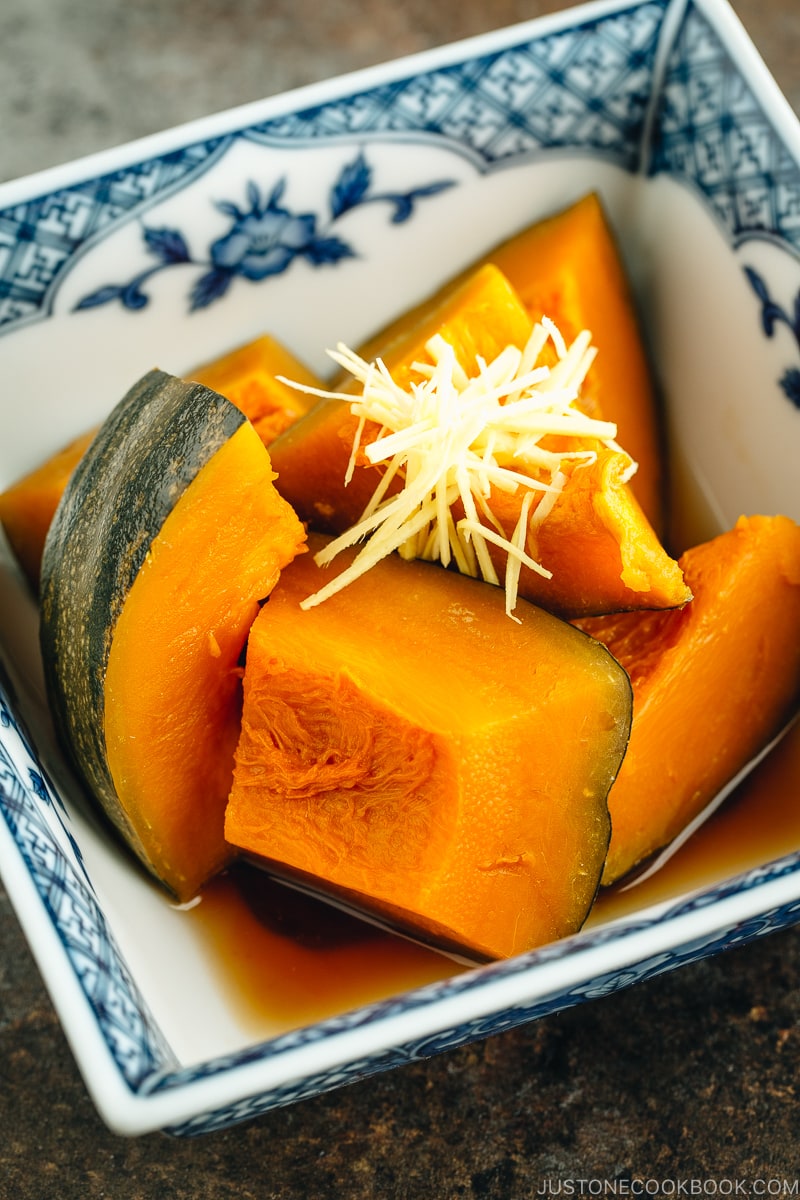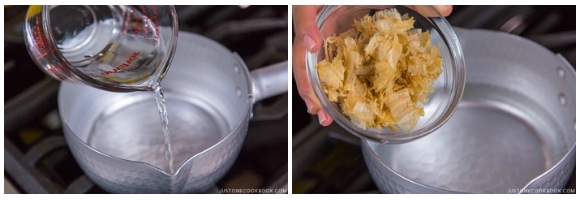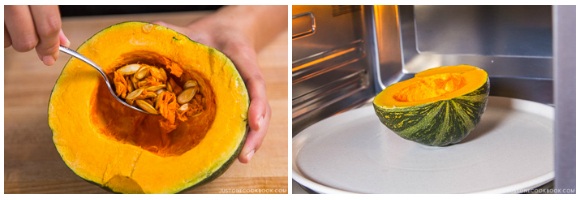Cooked in savory dashi broth seasoned with soy sauce and sake, this classic Japanese Simmered Kabocha Squash makes a satisfying and healthy side dish that is chock-full of nutrients. {vegan/vegetarian adaptable}

Japanese Simmered Kabocha Squash, or what we call Kabocha no Nimono (かぼちゃの煮物), is one of the most classic and popular simmered dishes in Japan. If you are traveling in Japan, you will see this kabocha dish everywhere. You‘ll see it in the bento box you pick up at the train station, as part of the side dishes of your teishoku (lunch meal set), or at the breakfast buffet in your ryokan (Japanese inn).
If you miss this hearty, comforting home-cooked dish, grab a kabocha squash at your local Japanese or Asian grocery store. It‘s easy to make this at home!
Simmered Kabocha Squash – A Classic Home Cooked Dish
A typical Japanese home-cooked meal includes at least one simmered dish called Nimono (煮物). It can be fish or meat or different types of root vegetables all cooked and simmered in one pot. Wholesome, nutritious, and easy to prepare, these simmered dishes are considered true home cooking in a Japanese kitchen. And they make up a fundamental part of washoku 和食.
It might be surprising to you, but most of the simmered dishes are seasoned similarly – with some kind of Japanese stock, dashi (see 6 varieties here), sake, mirin, soy sauce (and sugar). What makes it different?
Based on the ingredients, we modify the ratio of the seasonings. For example, kabocha squash itself is already very sweet and flavorful, so we go easy on the sweetness (mirin or sugar) and cut down on soy sauce since we don’t want the saltiness to overpower the dish.
3 Important Cooking Tips
1. Cut kabocha into equal size
Do not underestimate this simple tip. To make sure all the squash pieces are evenly cooked, you want to cut the kabocha squash in similar sizes. Smaller cubes will help speed up the cooking time as well.
2. Place kabocha in a single layer
Kabocha is very fragile once it’s cooked and it can break into pieces or mush easily. Therefore, you need to secure each kabocha piece, making sure they are laid in a single layer without overlapping in the pot. Then swirl the pot to mix the seasonings instead of using cooking utensils.
3. Simmer kabocha squash with just enough liquid and Otoshibuta
The amount of cooking liquid should be just enough to come to the top level of kabocha pieces in the pot. Overfilling with cooking liquid will only result in soupy kabocha, which we want to avoid.
Make sure to use an Otoshibuta (drop lid) so that the cooking liquid is forced to circulate, allowing the kabocha to cook evenly and quickly as they absorb the flavor.

Truly simple and rustic, I hope you enjoy making this Simmered Kabocha Squash recipe, especially in fall and winter. To experience more Japanese home cooking, check out other Nimono recipes on my blog and leave a comment below and let me know the kind of simmered dishes you have in mind.
Other Kabocha Squash Recipes

Wish to learn more about Japanese cooking? Sign up for our free newsletter to receive cooking tips & recipe updates! And stay in touch with me on Facebook, Pinterest, YouTube, and Instagram.

Japanese Simmered Kabocha
Ingredients
- 1 lb kabocha squash (½ small kabocha)
For the Dashi
- 1¾ cups water
- ½ cup katsuobushi (dried bonito flakes) (skip for vegan/vegetarian and make Vegan Dashi with shiitake and kombu)
For the Seasonings
- 2 Tbsp sake
- 1 Tbsp sugar
- 2 tsp soy sauce
- ⅛ tsp Diamond Crystal kosher salt
For the Garnish (optional)
- ginger (julienned; from 1-inch, 2.5-cm knob)
Instructions
- Gather all the ingredients.

- In a small saucepan, boil 1¾ cups water for the dashi. Once boiling, add ½ cup katsuobushi (dried bonito flakes).

- Mix together and turn off the heat. Set aside for 15 minutes. Then, strain the katsuobushi with a fine-mesh sieve. Now you have Katsuo Dashi. Set it aside for now. Reserve the spent katsuobushi to make furikake (rice seasonings).

- Remove the seeds and membrane from 1 lb kabocha squash and microwave it for 2 minutes to soften the outer skin. You can skip microwaving if you have a sharp knife and the strength to cut through the hard kabocha.

- Carefully cut the kabocha into wedges, then equal 2-inch (5 cm) pieces. Remember, we leave the skin on because kabocha skin is edible and nutritious.

- In a large pot, place the kabocha pieces in a single layer, skin side down.

- Add the dashi, 2 Tbsp sake, and 1 Tbsp sugar. Tip: Swirl the pot to mix the seasonings so you don‘t break the kabocha pieces.

- Cook on medium high heat and bring it to a boil.

- Add 2 tsp soy sauce and ⅛ tsp Diamond Crystal kosher salt, and swirl the pot again to mix the seasonings. The cooking liquid should come three-quarters up the sides of the kabocha pieces; if it does not, you can add a little bit of water. Bring it to a boil again.

- Once boiling, turn the heat to medium low to maintain a simmer. Cover with an otoshibuta (drop lid) and cook for 20–30 minutes (depending on the size of your kabocha pieces and how long it takes the skin to cook). You can tell it‘s done when the orange flesh of the kabocha has tiny, thin cracks near the skin or a bamboo skewer pierces the kabocha easily. If you feel that the liquid is evaporating too fast, you can cover the pot with a pot lid (with the otoshibuta still placed on top of the kabocha).

- Remove from the heat and let the kabocha sit covered with a pot lid until cool, about 30 minutes. This helps the kabocha absorb more flavor as it cools. You can serve it at room temperature or reheat before serving.
To Garnish (optional)
- Cut the ginger into thin slabs and then thin julienne strips.

- Soak in cold water for 1 minute to remove some of the spiciness and drain well. Sprinkle the ginger on top of the simmered kabocha and serve.

To Store
- You can keep the leftovers in an airtight container and store in the refrigerator for 2–3 days or in the freezer for a month.
























Hi! I love this dish. One question though – Once you’ve taken it off the heat, you mention that it should be ‘covered’ while it cools. Does this mean covered with the otoshibuta, or covered with a regular lid? Thank you!
Hi Sydney!
Thank you very much for trying this recipe and for your kind feedback!
Thank you for bringing this to our attention. We added more clear directions to the recipe card.
Step 11: Remove from the heat and let kabocha sit covered (with a pot lid) until cool.
Thank you!😊
Nimono reminds me of my mom. I like a dash of yuzu dressing before serving and eat nimono with gohan and a simple furikake. For me it is definitely comfort food. Thank you for sharing this recipe.
Hi Elizabeth!
Aww. Thank you very much for sharing your story and for your kind feedback.☺️
Delicious! I got a kabocha squash and wanted to make something to remind me of my trip to Japan back in 2019. This was easy to make and hit the spot. Love the subtle flavors the broth gives to the kabocha.
Hi Anne!
Thank you so much for trying this recipe and for your kind feedback!
We’re so glad to hear you love this dish! ☺️
Can you make this with konbu dashi and not katsuobushi to make it vegetarian? Will it change the taste?
Hi MH,
You may use Konbu Dashi for this recipe. However, Konbu Dashi has a milder taste than Katsuo Dashi, and you may taste more condiments taste with this recipe. So please adjust the condiments amount to your liking.😉
Just bought mine, will be making this recipe this weekend!
Hi Candy,
Thank you very much for trying this recipe. We hope you like it! please let us know how it goes!
Delicious seasoning! (I don’t like nuking anything in the microwave, so that’s my own preference, so I didn’t have it pre-cooked.) I had about the right level of water, according to description and photos. I set timer for 20 minutes and cooked at medium low heat and unfortunately squash came out overcooked. Well now I know for next time.
Hi Deborah! Thank you for your kind feedback. I should have explained, but the microwave is to make the outer skin softer so the knife goes through (otherwise it’s a bit tough). Kabocha’s cooking time is really depending on the skin + flesh thickness. Sometimes they are thinner than others, then must cook less time. Keep the skewer handy and check once in a while. 🙂
Unfortunately I think this is the first dish I’ve given a 3/5 on this site. We make dashi broth quite often but this dish just tasted so fishy with the kabocha. The ginger was able to cut it a bit but most of it went in the compost. Won’t be making again.
Hi Jean! Thank you for your honest feedback. 🙂
Hi Nami – if I make this in the instant pot, do I need to adjust any of the quantities? Also, how long should I cook it for? Thank you!
Hi Julie! I’ve never made this dish in the IP, but it should be fast, 1-2 minutes and quick release after leaving for 10 minutes? I haven’t tried that myself, so please adjust according to your trial. Also, the cooking time depends on how big you cut the kabocha too. 🙂
I used the recipe and it turned out delicious! Cooking it again today. Thanks for sharing the recipe!
Hi Lorraine! Thank you for your kind feedback! I’m so glad to hear you liked the recipe! xo
The kabocha tasted so good. Thank you!
Hi Suzan! Thank you so much for trying this recipe and for your kind feedback! I’m so happy you enjoyed it! 🙂
[…] Simmered Kabocha […]
[…] Simmered Kabocha Squash […]
[…] Simmered Kabocha […]
[…] 11. Simmered Kabocha Squash […]
[…] Simmered Kabocha […]